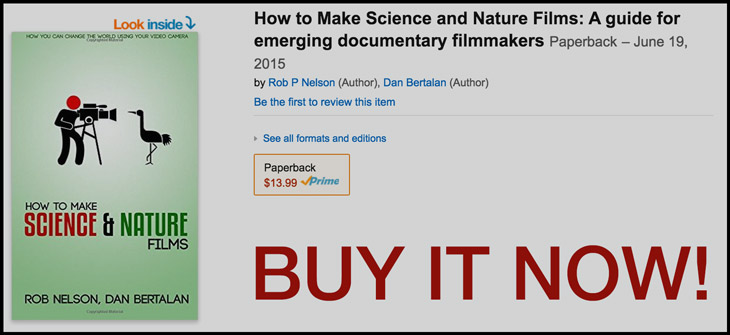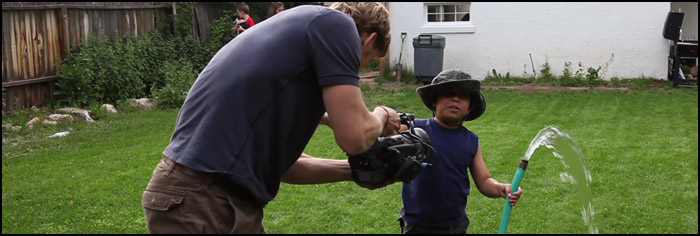Getting Started in Science and Wildlife Filmmaking
Films that excite and inspire
The greatest tool you have as a filmmaker is the drive to engage and inspire your audience. Your passion can help create change and drive useful action. You will come up with an idea, determine your audience, and start making your film. But be sure to begin with an idea that truly drives you in order to inform change and inspiration in others.
More from this series:
- How to Choose a Topic for Your Video
- How to Shoot Interviews
- Audio Basics
- How to Shoot Better B-Roll
- How to Frame your Story in the Edit
- How Copyright Works
- Editing Things to Do Before your Video is Done.
- DSLR Camera Basics
- How to Shoot 360 Degree Video
- 52Things – the Series
We have a new book – Making Science Films!
In 2005, Jean-Michel Cousteau, the son of legendary ocean explorer Jacques Cousteau, traveled to the Northwest Hawaiian Islands, the uninhabited chain of islands 1600 miles northwest of the main Hawaiian Islands. On the expedition, the diversity of sea life in the area completely blew the team away. However, they also witnessed a myriad of trash piled up on the beaches, washed there from the wind and waves of the Pacific Ocean. Watching the debris affect the fragile ecosystem, Cousteau and his crew knew they had to do something. It seemed only natural to make a film that would demonstrate the delicate nature of the area and warn people about the harmful impact of pollution. Like every filmmaker, Cousteau hoped the film would make a difference. He didn’t realize then just how important it would become.
Only a year after making the film, Voyage to Kure, Cousteau found himself in the company of President George W. Bush and a powerful White House committee dedicated to preserving the environment. After watching the film, Bush turned to the committee and said, “Let’s get it done.” He proceeded to set aside the entire Northwestern Hawaiian Island chain as a protected monument. Cousteau’s passion and story motivated this special audience to take action, and it changed the course of history for one very delicate ecosystem.
Though few viewers wield Presidential-sized power, many of them, if motivated, can still influence powerful decision-makers or take action to ensure a message is heard. You never know who will see your film or be influenced by it.
In the past, breaking into the science and wildlife filmmaking industry was a costly and difficult process. Jean-Michel Cousteau is a living legacy of his father; that family connection no doubt helped him establish his name in the business. Fortunately for you, times have changed in the industry. You no longer need the fortune of family connections or independent wealth to become a successful filmmaker.
You do, however, need some basic equipment, education, a willingness to meet people, and a little ingenuity to begin.

Equipment
In the past, the 35mm film camera that was typically used to shoot wildlife footage was the cost equivalent of a modest home. If you combined the purchase of the camera, film processing, and a professional editing suite, you are now in the price range of a very nice home!
But thanks to the dawn of the digital age, filmmaking has become much more affordable. Today you can buy a high-quality, HD camera for several hundred US dollars. The same goes for a laptop with editing software. Even more good news: today’s cameras capture directly to digital storage, eliminating the need for expensive tapes and tape decks to play back and digitize footage. So with a (relatively) small investment almost anyone with the motivation can afford to make science or wildlife films.
If you are unable or unwilling to spend that much money, don’t worry. You don’t need the latest and greatest gear, and you might be surprised by what you find online in affordable, used, or discounted HD video cameras and digital equipment. The specific equipment you will need for various settings will be addressed in later chapters. Though your gear is important, remember that equipment does not define you as a filmmaker. What does? Keep reading.
Education
There are numerous ways to educate yourself about filmmaking. In addition to the many websites devoted to filmmaking techniques, a handful of schools have emerged to lead the way in teaching the specifics of science filmmaking. They allow beginning filmmakers to formally learn the trade with a small group of fellow students, guided by instructors who have established themselves in the industry. Some of these prestigious schools include Montana State’s Science and Natural History Filmmaking program and New Zealand’s University of Otago. (We discuss these and other programs in more detail here.)
Networking
Like many other professions, learning the craft of making films also relies heavily on networking with other filmmakers. Making connections is an integral key to success. There will be a point in your filmmaking career when you will need to sell others on your film concept; having meaningful relationships with other filmmakers and producers will help you in this cause.
Networking may seem intimidating early in your career, but remember that every filmmaker, producer, director, host, or broadcaster you meet was once a beginner, and few forget what that was like. The people who are making their first films at the same time as you will be your peers in the industry for years to come. (If you’re lucky, you’ll also come away with creative and amazing friendships.) Here are a few tips to consider when trying to establish and expand your connections in the business.
- Seek out Internet affiliations. This is even more important if you’re planning to distribute your films online!
- Attend film festivals, such as Bristol’s Wildscreen or the Jackson Hole Wildlife Film Festival.
- Contact other science filmmakers on the Internet. Compliment their work; ask questions; offer to meet when in town. Most are willing to help, so don’t hesitate to ask or to begin a conversation with someone whose work you admire. I’ve reached out like this to nearly everyone I now work with (including my wife, Haley).
- Attend local film clubs, or, if none exist start your own with a regular movie night.
- Join broadcaster or filmmaker associations.
A Little Ingenuity
Decades ago, one way for a beginning filmmaker to get his or her film in front of an audience was to produce multiple VHS tape copies and distribute them. This made for another costly investment, and unfortunately, the advent of DVDs did not reduce these distribution costs very much. In fact, without some funding mechanism, it is cost-prohibitive for most beginning filmmakers to reach a broad audience with their films. Broadcast television is typically exclusive to established production houses. Your chances of gaining immediate recognition as an independent filmmaker through these mediums are limited, so, in an effort to save your friends and family members from watching countless hours of your films, you should consider alternate ways to broadcast your films. But fear not…
The digital age has again given you a distinct advantage over your predecessors. It has never been easier to “broadcast” your films to either a small target audience or a mass audience with broad appeal. The Internet allows you to broadcast films on your own science or wildlife Internet channel, via iTunes or YouTube.
We started Untamed Science because three of us, fresh out of a science education, wanted to produce science and natural history films that would impact the classroom. The twist behind our films is that we are trained scientists who use action and adventure to portray ideas and concepts. We mix in humor, high-adrenaline situations, and genuine action in our videos, elements that we thought classroom science films needed to connect with students. This approach was pretty atypical of science films at the time, and our iTunes channel quickly became popular. Soon we were having meetings with publishing companies and broadcasters like Nat Geo and Discovery. Eventually we were contracted to produce more than 200 science-education videos for the world’s largest publisher of science textbooks. These films are currently being watched by half the K-12 students in America. Hopefully, our films will inspire these students.
Our story may be unique, but having passion and just starting the process are so important. We bring this ideology to our filmmaking process, and it’s fundamental to our success.
Of course, the craft of science and wildlife filmmaking is also a business whose ultimate success depends on the right blend of passion, using that passion to motivate yourself and others, and marketing your ideas in the right way and to the right people. Now let’s start planning that film!
Articles Worth Reading
- Rob’s Story: How I got into Wildlife Filmmaking
- What makes science videos engaging in the classroom
- “Don’t Overthink it” – Filmmaker Gives Advice On How to Become a Science Communicator
Try Something New Every Week
Finally, it’s worth noting that you should try something new every week, even if you’re already a professional. Here is our new series where we have a new thing to teach each week. See the full blog with every video here:




































































































Wonderful section. Congratulations.